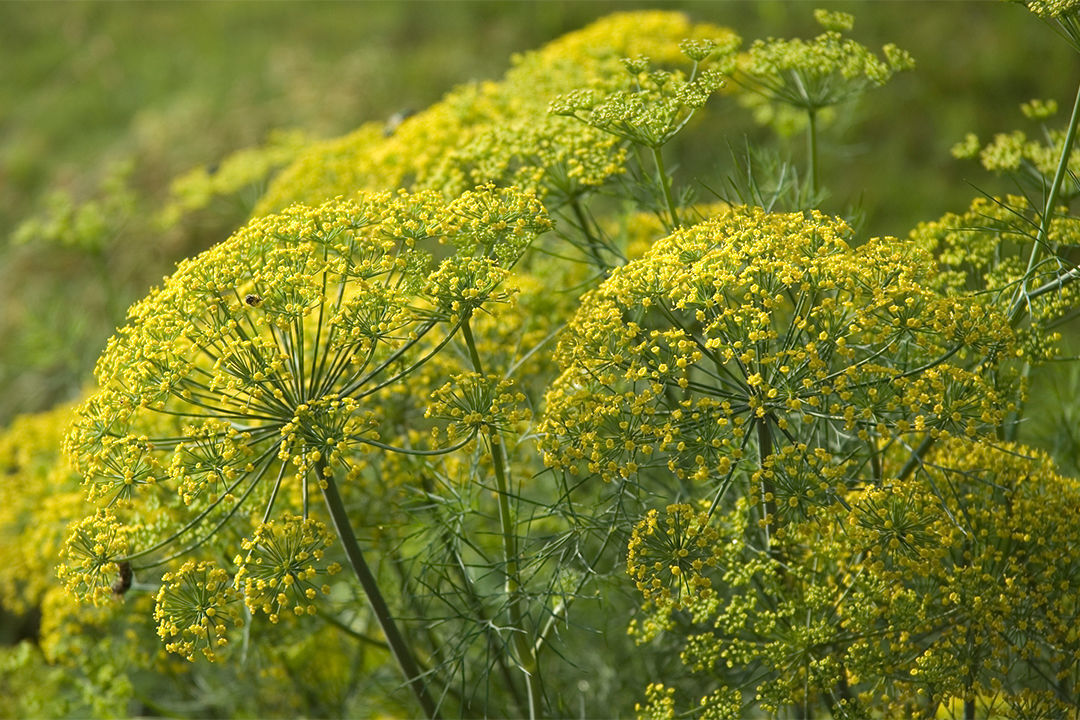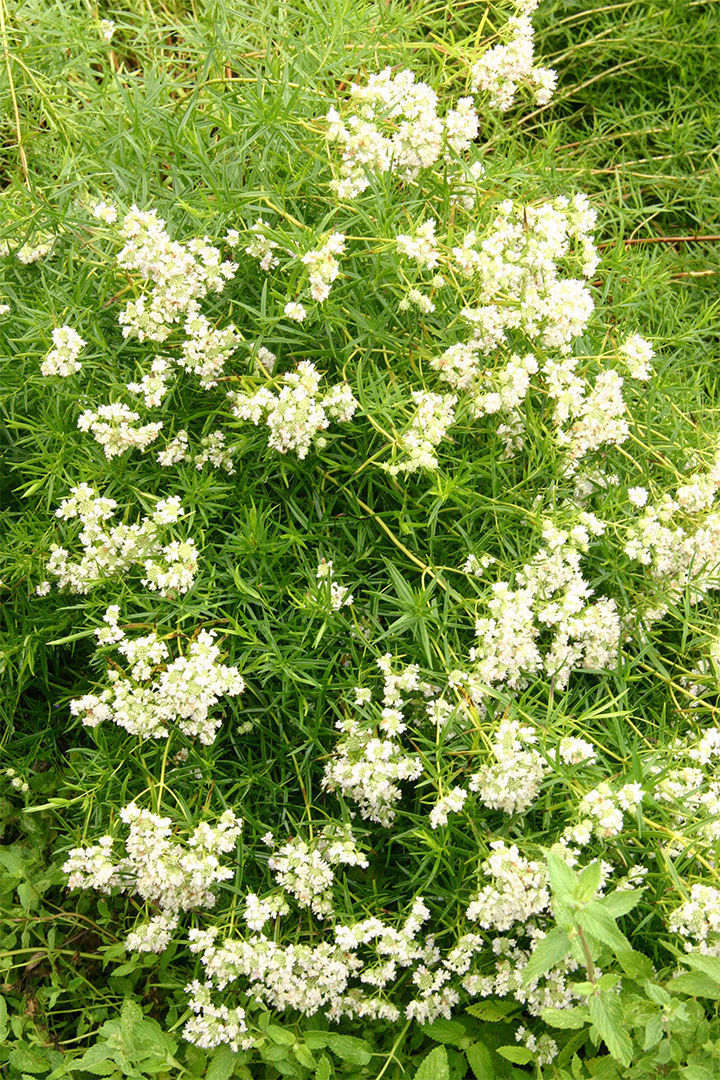Bring in the Beneficials
If you want plants that look great and keep pests in check, our experts have some suggestions for you

Gardens for butterflies and bees are easy. Dozens of books, magazine articles, and websites out there will guide you through lists of pollinator-friendly plants like butterfly bush (Buddleia spp. and cvs., USDA Hardiness Zones 5–9), butterfly weed (Asclepias spp. and cvs., Zones 4–9), and lantana (Lantana camara* and cvs., Zones 7–11) that—once placed in your yard and blooming—will attract these beautiful insects. What these plants might not do so well is attract beneficial insects such as lady beetles and parasitic wasps that aren’t as flashy but will help protect your garden from aphids, caterpillars, thrips, and other insects that like nothing better than to feed on your plants.
Beneficial insects tend to be attracted by pollen and nectar, so almost any flowering plant will bring some in. As a general rule, however, double flowers do not attract as many beneficial insects as single flowers. This is because doubles are usually mutations in which the male parts of the flowers, the stamens, develop into petals. With the male parts of the flower missing, there is no pollen and usually significantly less nectar as well.
The plants in this article have been shown through research at various universities to harbor beneficial insects beyond what other plants typically do. Though some researchers have reported that exotics attract fewer beneficial insects, other researchers have found otherwise. We leave it to you to decide what mix of natives and exotics you want in your own garden.
Ground covers and herbs do more than they are marketed for
Carpet bugle can choke out weeds
Ajuga reptans cvs.
Zones: 3–10
Size: 4 to 8 inches tall, spreading indefinitely
Conditions: Full sun to full shade
Of all of the plants on this list, perhaps the most common and adaptable perennial ground cover for gardens is carpet bugle. It does equally well in full sun or partial shade and is effective at covering areas beside walkways and sidewalks. Native to Asia and Europe, this plant is very attractive to hoverflies. Lucky for gardeners, several distinctive cultivars, such as ‘Black Scallop’, provide dark, bold texture. Others, like the fine-textured ‘Chocolate Chip’, are perfect for filling in around other perennials. There are even cultivars such as ‘Catlin’s Giant’, with extralarge, showy flower spikes. With all of its remarkable versatility, there is one concern to be aware of: Avoid placing this spreader next to turf, unless you enjoy the mosaic aesthetics of “bugle lawn.”
Sweet alyssum offers steady blooms and fragrance

Lobularia maritima
Zones: Annual
Size: 3 to 6 inches tall and 8 to 10 inches wide
Conditions: Full sun to partial shade.
Another plant known to attract hoverflies as well as parasitoids is sweet alyssum. This small, white-flowered annual prefers a little bit of shade in the South but thrives in full sun in northern regions. It usually stays less than a foot tall and prefers well-drained soils. Northern gardeners have the benefit of a long bloom season. If planted in the spring, sweet alyssum will grow until fall and into early winter. New cultivars have extended this benefit to southern gardeners as well. ‘Snow Princess’ has been an excellent performer in Charlotte, North Carolina. The “sweet” in sweet alyssum comes from its delightful honey fragrance. It works extremely well in containers or for filling gaps along stone walls. If sweet alyssum is planted in a hanging basket, the air can grow thick with beneficial insects seeking out nectar, providing a fantastic opportunity to view a wide variety of wonderful insects. This plant is native to the Mediterranean.
Dill is a food source for bugs and humans, just not in the same way

Anethum graveolens
Zones: Annual
Size: 2 to 3 feet tall and 1 to 2 feet wide
Conditions: Full sun; well-drained soil
Some of the plants that are most attractive to beneficial insects are also common inhabitants of the vegetable garden. Grown as annuals or biennials throughout the United States, dill and coriander (Coriandrum sativum, annual) are excellent choices for attracting beneficial insects, particularly hoverflies, parasitoids, and lady beetles, as well as being useful, tasty parts of salads, soups, or salsas. Both of these plants are native to Europe and prefer the full sun that most vegetable gardens offer.
Two-row stonecrop works hard for you and for hoverflies

Sedum spurium cvs.
Zones: 3–9
Size: 3 to 6 inches tall and 12 inches wide
Conditions: Full sun to partial shade
Two-row stonecrop is an evergreen perennial native to Asia. This stonecrop is low growing, usually reaching only a quarter- to a half-foot tall, and is attractive to hoverflies. It can function well as a dense ground cover or as a crack filler along a stone wall. The pink-and-white flowers are small but attractive. This plant is a succulent and handles low-water situations well.
Everyone likes the blue of bachelor’s button

Centaurea cyanus and cvs.
Zones: Annual
Size: 2 to 3 feet tall and 1 foot wide
Conditions: Full sun; well-drained soil
A perfect pick for the beginner, bachelor’s button offers large blue, pink, or white flowers. Also known as cornflower, this classic cottage-garden annual returns year after year from its own self-seeding. The blue of the straight species never fails to charm and is even used to define a shade: cornflower blue. The flowering stems work well in fresh and dried arrangements. Bachelor’s button links us with early colonial gardens, as this plant was grown here as early as the 17th century. Native to Europe, bachelor’s button attracts lady beetles, hoverflies, and predatory bugs. It prefers a sunny location. Start plants by direct-seeding in late winter or early spring for late-spring bloom. As summer heat intensifies, bachelor’s button will decline, dropping seed for next season.
Get fuzzy, fragrant foliage from fern leaf yarrow
 Achillea filipendulina and cvs.
Achillea filipendulina and cvs.
Zones: 3–8
Size: 2 to 3 feet tall and wide
Conditions: Full sun to partial shade; normal to dry soil
Yarrows are extremely effective at bringing in beneficial insects. Common yarrow (Achillea millefolium and cvs., Zones 3–9) is a perennial that can be used as a slow-growing ground cover in full sun and can take over an area through reseeding in some portions of the country. It will bloom for several months if left to its own devices and all season long if trimmed back after the first blooms fade. This plant is native to Europe, Asia, and North America and tolerates moderate drought and dry soil. Fern leaf yarrow, a close relative of common yarrow, is also attractive to beneficial insects, including lady beetles, lacewings, and parasitoids. A native of Asia, this perennial has fine foliage and attractive yellow flower heads. Both species and cultivars have the added surprise of fragrant foliage when crushed.
Native options abound
Narrowleaf mountain mint is an easily controlled native

Pycnanthemum tenuifolium
Zones: 5 to 8
Size: 2 to 3 feet tall and wide
Conditions: Full sun to partial shade; tolerates dry soil
So far, most of the plants we have looked at have been introduced to North America. Plenty of natives, however, attract beneficial insects as well. One native perennial that deserves more attention is narrowleaf mountain mint. A native of Eastern North America, this white-flowered plant will reach 3 feet in height and attract parasitoids. Fine-textured and elegant, this beauty looks best in a meadow setting mixed with grasses and other wildflowers. A mountain mint in bloom is a pollinator party. You’ll be amazed at the activity among the many small blooms topping the plant. As a mint, this plant provides a burst of stimulating fragrance when brushed by a careless leg or hand. It spreads by rhizomes like other mints but is easily pulled to keep it in check.
Horsemint beats bee balm for bugs

Monarda punctata
Zones: 4–9
Size: 2 feet tall and 1 foot wide
Conditions: Full sun to partial shade; average to dry soil
Horsemint is a tender reseeding perennial known for bringing spiders into the garden. This thyme-scented plant thrives in well-drained soils. The whorls of flowers are eye-catching and worth a close inspection. Showy pink bracts masquerade as flowers, drawing your eye in to discover the yellow, adorably freckled true flowers. Besides eight-legged beneficials, this plant is also attractive to parasitoids. Horsemint’s cousin, wild bergamot (Monarda fistulosa, Zones 3–9), also helps attract beneficial insects. These perennials are native to most of the United States east of the Rocky Mountains and are a well-behaved (more clumping, less spreading) substitute for bee balm (Monarda didyma and cvs., Zones 4–10).
Hyssopleaf thoroughwort looks wild and woolly

Eupatorium hyssopifolium
Zones: 4–9
Size: 2 to 3 feet tall and 1 to 2 feet wide
Conditions: Full sun to partial shade; average to dry soil
Beneficial insects aren’t your only garden helpers. Hyssopleaf thoroughwort is wonderful for attracting and harboring spiders. Native from New England to Texas, this perennial holds a panicle of white flowers up to a height of 3 feet. With its somewhat untamed look, it is best planted in informal areas where its wild and woolly appearance will be an asset. The texture, size, and habit are so similar to those of narrowleaf mountain mint that the two are visually almost interchangeable, even though they are unrelated. Use both in a naturalistic design to encourage more beneficial insect diversity with a uniform look.
This penstemon is a tall, good-looking westerner

Penstemon strictus
Zones: 4–8
Size: 1 to 3 feet tall and wide
Conditions: Full sun; well-drained soil
A knockout anywhere it’s planted, Rocky Mountain penstemon has an amazing spike of blue-purple flowers that will reach a height of 1 to 3 feet. This perennial is native to many western states. Though it prefers a lighter soil, it will handle heavier soils in a pinch. Lady beetles and hoverflies are common visitors.
Bringing beneficial insects into your garden isn’t difficult—it’s just a matter of planting material that these garden helpers can use as a food source. Be on the lookout for other plants that bring good insects into your yard. This list is just a start to the number of plants you can use to make your garden attractive to useful insects beyond butterflies and bees.
Basics
Know Who Your Friends Are
If you are going to invite beneficial insects into your garden, you should know who you are looking for.
Jeff Gillman and Paula Gross are the director and assistant director, respectively, of the University of North Carolina at Charlotte Botanical Garden.
Photos, except where noted: Bill Johnson; Klaus Reitmeier/Alamy; Ann E. Stratton; Michelle Gervais; Kathryn Geruntho Frank; Kerry Ann Moore; Stephanie Fagan; Abigail Lupoff; Joshua McCullough; Robert Shantz/Alamy; millettephotomedia.com
Sources
The plants in this article can usually be found locally or from these online sources:
• High Country Gardens, Williston, VT; 800-925-9387; highcountrygardens.com
• Prairie Moon Nursery, Winona, MN; 866-4178156; prairiemoon.com
• Rare Find Nursery, Jackson, NJ; 732-833-0613; rarefindnursery.com












Comments
Log in or create an account to post a comment.
Sign up Log in